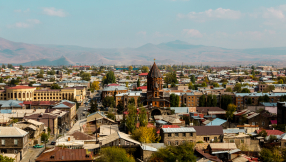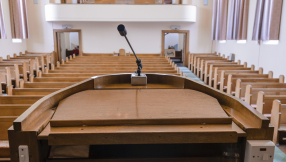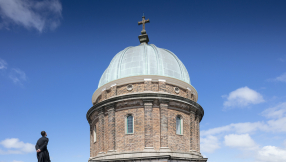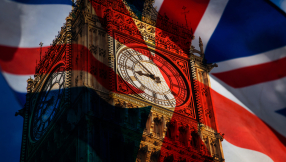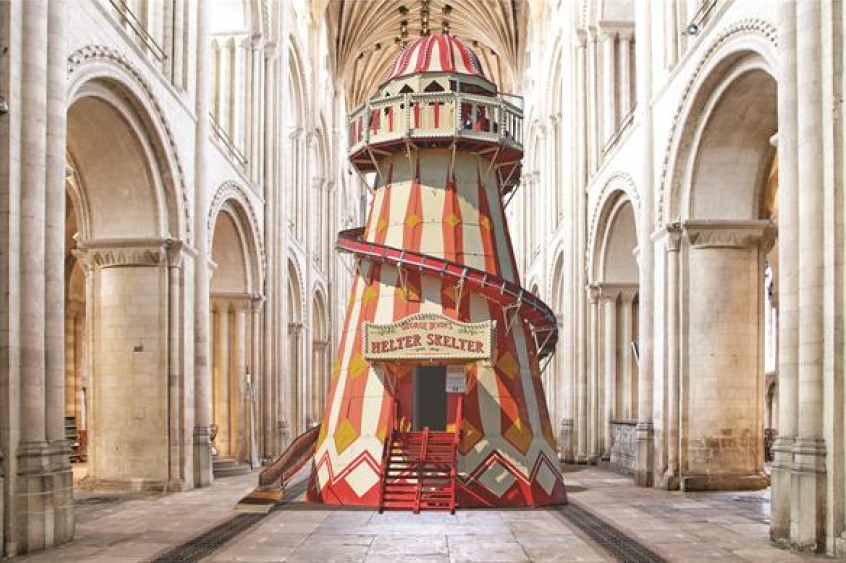
One of the treasures of my home here in a Jewishly observant part of Broughton Park, Salford, is a painting of the stained glass windows of Norwich Cathedral, which I sold for the artist 50 years ago. Miraculously, this object of beauty has recently found its way back to me and it now hangs on the wall of my lounge, reflecting the stained glass of the windows of my 100-year-old house, especially towards the end of the day, when the room is bathed in sunlight.
It comes to my mind now as the real Norwich Cathedral, built in 1145, is very much in the news at the moment as, recently, the church authorities have decided to attract the young by the offering of a helter skelter adjacent to these very same beautiful stained glass windows.
Similarly, Rochester Cathedral, one of the oldest, dating from 604 CE and a Grade I listed building to boot, now boasts a crazy golf course within its sacred precincts. Other cathedrals may well be following suit.
My friends in the local church up here are puzzled by this turn of events. They tell me that this country's cathedrals have actually been witnessing an increase in visitors for a number of years, without the need for gimmicks and bribes. It is ordinary churches that are seeing the fall in attendance, they say.
Not surprisingly, the helter skelter and other 'gimmicks' have raised some debates around the sacredness of church buildings and I wonder if I - coming from that Jewish rock from which the Christian faith was hewn - might be able to contribute something helpful in terms of how we understand the sanctity of our buildings.
When the Second Temple was destroyed by the Romans in 70 CE, synagogues had already been around for ages. The destruction, although a shock, was in many ways expected. The Priests were mere stooges of the Roman authorities, after all, not too dissimilar from the contemporary Russian Orthodox Church you could say...
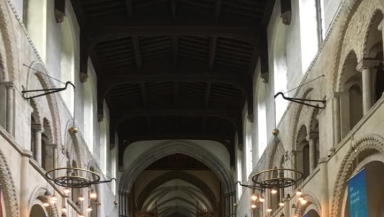
But to explain, the Temple is not actually called the Temple in Hebrew and the English rendering gives quite a different impression altogether. It's called the 'house/home'. Even in academia we call the First and Second Temple periods the Bayit Rishon and the Bayit Sheni. In other words, the First and Second 'House' periods or 'Home' periods.
What was the Mishkan (Tabernacle) all about? The precursor to the house which became the home was not a Tabernacle, as it's often translated. In Hebrew, it has always been an indwelling in us that carries us everywhere we go. All these translations from Hebrew tend towards alienation and not towards homecoming.
The idea of the Mishkan which became the Bayit - the house/home - is the unique Jewish idea of the indwelling of G-d which became the focal point for people who were no longer to act as a slavish entity from Egypt, but as a cohesive unity about to be scattered all over Israel and later also to be flung wide into diaspora, but wanting to make a pilgrimage once in a while back to their true home, the Bayit, the Temple.
The rabbi was and remains to this day a teacher or learned person. The term derives from the Hebrew word 'rav' meaning 'teacher', with the idea being that those attending synagogue were, through a vast variety of learning programmes, able to argue and dispute with the rabbi on his own level. Because Judaism is not a top-down religion, but really a bottom-up religion, which is the secret of its success in a largely hostile diaspora.
Therefore, the main aim of the rabbinic or 'Pharisee' movement that developed over a number of centuries before the destruction of the Second Temple was that everyone should attain the same level of knowledge and understanding of Jewish thought and practice.
As such, there is no concept of laity in Judaism and when the rabbi is absent, any Jewish man over the age of 13 is able to officiate in his stead, and often does so even when the rabbi is present. This is because under Jewish law, a boy is considered to have entered manhood once they reach the age of 13, a milestone that is celebrated with the Bar Mitzvah. This is one aspect in which Jewish practice in the sacred space differs from Christian churches, where an adolescent might be given a secondary role like singing in the choir or giving a reading but not be expected to run the service when the priest is away on holiday, or give learned sermons to the whole congregation.
READ MORE: Crazy golf in cathedrals: a tool for mission or compromising the sacred?
You might already be aware that the name for the Israeli Parliament - the Knesset - actually derives from Bet Knesset, which as I explained earlier means the house of gathering. When I lived in Israel and watched my first Knesset debate in 2006, on a friend's TV in beautiful Haifa, just after she herself had been bombarded in the Second Lebanon War, it occurred to me that the Israeli Knesset, the Parliament, and its namesake, the Bet Knesset, were not just similar in sound but also in function.
There is no division of 'Church and State' in Judaism as there might be in, say, the US. That explains why during the first post-war session in 2006, the Prime Minister of Israel went around shaking everyone's hand after business, just like a Bar Mitzvah boy would do in our synagogue. It was amazing to see; this person who had just had to authorize the defence of Israel from invasion by Hezbollah was almost like his younger 13-year-old self back on his Bar Mitzvah day.
As you will already know, the Jewish house of worship is called a 'synagogue' and as you might have guessed too, it is not actually a Hebrew term; it is Greek. In Hebrew - the sacred language which has been resurrected in the last 70 years of the State of Israel and the hundreds of years before that - the communal place where we pray is called not synagogue, but rather Bet Knesset - the 'house of gathering'. It is also known as Bet Midrash - the 'house of learning'.
But you may be interested to know that we do not call it - at least not normally - the house of prayer. This is because Judaism is not a faith in the sense understood by the Church and prayer is actually only one element of Jewish religious life.
The synagogue as we have known it for over 2,000 years is really a focal point for the community, and also and most importantly, a place for study. If anything, it is the community and 'learning' the Torah (Bible) and Oral Law (Mishnah and Talmud) which are sacred in Judaism. And crucially, in Jewish eyes, it is people who render a place 'holy'.
Having said that, I asked my rabbi a couple of days ago whether, given that the synagogue is a focal point for the community, he would consider introducing a helter skelter into the main part of the synagogue. You can guess what the answer was: complete shock!
I did try my best to persuade him that it might be a good idea, but he wouldn't be swayed. At times I felt like I was Abraham arguing with G-d about Sodom and Gomorrah. But he simply wouldn't be moved on the matter!
To be honest, I was acting as 'devil's advocate' because I already knew what the answer would be. Once or twice I have myself been up on the bimah from where the rabbi officiates – this was during the week when I used to take round children who weren't Jewish in order to teach them about Judaism for the school curriculum. As soon as I stepped onto the bimah, I felt a complete sense of awe.
Although we all love children in the community and gear the synagogue services towards them, a helter-skelter and mini-golf in this place would simply be inappropriate. The synagogue grounds would be fine for a helter skelter, but not the part of the synagogue where prayers are said. And that is even though we do not have the same differentiation between sacred and profane in Judaism as there is in Christianity.
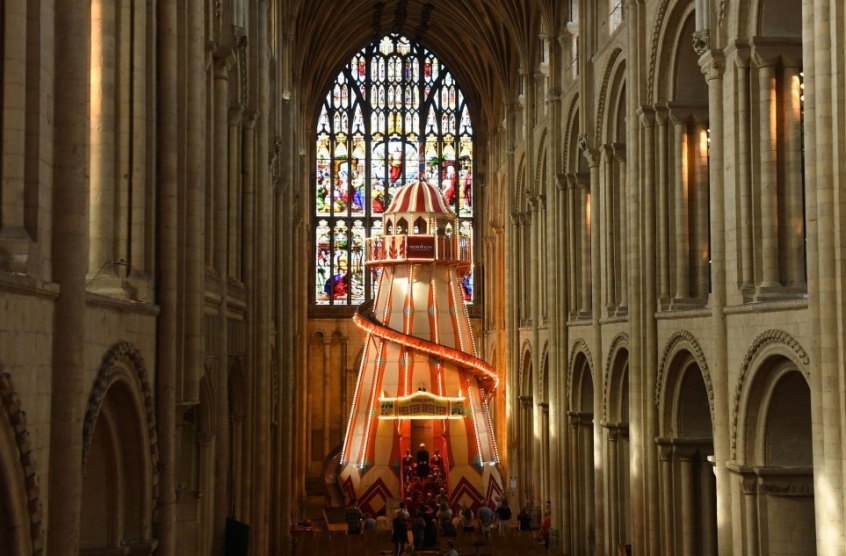
It is interesting to me that our community is living and growing and even attracting converts, which we do nothing at all to encourage. It often means that these very courageous individuals, many of them from ethnic minority groups, have had to give up so much and spend so much time learning to become part of our of reviled religion.
Who on earth would want to put themselves through that, you might ask yourself? What on earth is our secret? What do we do to make Judaism work in a godless society?
The appeal might lie perhaps in the 'triangular partnership' in Judaism, our own special 'Holy Trinity' of home, school and shul. It all starts in the Bayit (the house or home), with reinforcements in school, and then shul, the Yiddish word for synagogue that interestingly also means 'school'.
In that sense, life really is a book for us Jews. And everything is learning and doing, doing and learning, all for the sake of heaven.
And yet it is not learning in any shape or form. That is perhaps the reason why the great many friends and colleagues in the Jewish community I have asked as to whether they would like a helter skelter or mini golf in that part of the shul where prayers are said have emphatically answered 'No'. That includes those friends with children at a loose end during the summer holidays.
The park round the corner from the synagogue has a great playground with swings, see-saws, slides, helter skelters, and much else. There is room to play ball, cricket and even football, plus an auto-bench which, when you press the button, allows you to hear the voice of a much beloved Holocaust survivor telling his story.
During the school holidays, Jewish children tend to visit the football museum in the centre of town or go on outings organized by various informal Jewish youth groups which cater for all ages. It is doubtful in any case if helter skelters and mini golf in shul would actually attract young people to attend regularly.
But then, the shul is not the focal point of religion in Judaism – the home and the school are probably more important, with the shul functioning as a back-up to the input already provided by parents and teachers.
This is not to downplay our shul – not at all – it's a wonderful place with terrific rabbis and loads of learning for all ages. They even honoured me recently when I gave the first ever dvar Torah by a woman in North Manchester. But in Judaism the first building to be built has to be the school and also the mikveh (ritual bath).
Synagogues can be housed in a house – this is often the case in our area - and that is perfectly okay because as I have said, it is learning and people that count in Judaism, more than the building.
As for the Church, if it wants to attract more people to daily or weekly worship, it might train priests and vicars more rigorously in Jewish and Christian sources, start in the home, educate in the school and then use the Church for reinforcement.
The Temple is really a 'home' in Hebrew, and the Tabernacle an 'indwelling'. So might the Church look to the Jewish 'rock from which you were hewn'? By all means appreciate the stained-glass windows in Norwich Cathedral and the historic magnificence of Rochester Cathedral but most of all, invest in education.
Dr Irene Lancaster is a Jewish academic, author and translator who has established university courses on Jewish history, Jewish studies and the Hebrew Bible. She trained as a teacher in modern Languages and Religious Education and gained 1st prize as 'teacher of the year', and received a government bursary from Tony Blair's government for 'excellence in teaching.'










